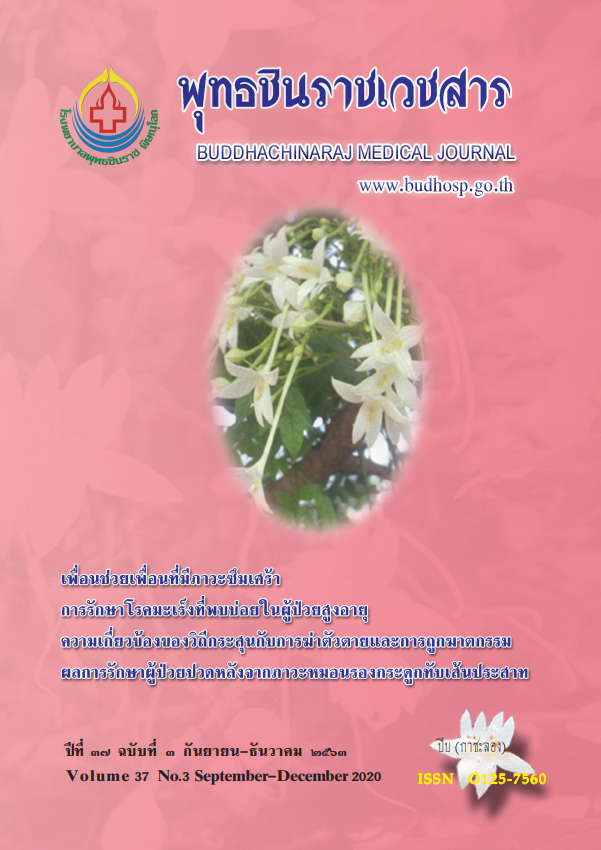ปัจจัยที่เกี่ยวข้องกับการใส่ท่อระบายน้ำหล่อเลี้ยงสมองแบบถาวร ในผู้ป่วยเลือดออกในสมองส่วนธาลามัสและแตกเข้าสู่โพรงสมอง
การใส่ท่อระบายน้ำหล่อเลี้ยงสมองแบบถาวรในผู้ป่วยเลือดออกในสมองส่วนธาลามัส
คำสำคัญ:
ภาวะเลือดออกในสมองส่วนธาลามัส, การผ่าตัดระบายน้ำโพรงสมอง, ภาวะน้ำคั่งในโพรงสมองบทคัดย่อ
ภาวะเลือดออกในสมองส่วนธาลามัสและเลือดออกในโพรงสมองทำให้เกิดภาวะน้ำคั่งในโพรงสมองซึ่งรักษาโดยการผ่าตัดใส่สายระบายน้ำในโพรงสมองแบบชั่วคราวและ/หรือแบบถาวร การศึกษาแบบวิเคราะห์ชนิดมีกลุ่มเปรียบเทียบนี้มีวัตถุประสงค์เพื่อประเมิน ปัจจัยที่เกี่ยวข้องกับการผ่าตัดใส่สายระบายน้ำโพรงสมองแบบถาวร โดยทบทวนเวชระเบียนผู้ป่วยเลือดออกในสมองส่วนธาลามัส ที่แตกเข้าโพรงสมองที่ได้รับการผ่าตัดใส่สายระบายน้ำหล่อเลี้ยงสมองในโพรงสมอง ณ โรงพยาบาลพุทธชินราช พิษณุโลก ระหว่างวันที่ 1 ตุลาคม พ.ศ. 2559 ถึงวันที่ 30 กันยายน พ.ศ. 2562 ซึ่งมีผู้ป่วยทั้งหมด 81 คน เพศชาย 42 คน (ร้อยละ 51.9) อายุ เฉลี่ย 63.7 ปี อายุน้อยกว่า 60 ปี 41 คน (ร้อยละ 50.6) ได้รับการผ่าตัดใส่สายระบายน้ำในโพรงสมองแบบชั่วคราว 72 คน (ร้อยละ 88.9) ผ่าตัดใส่สายระบายน้ำแบบถาวร 16 คน (ร้อยละ 19.8) และผ่าตัดใส่สายระบายน้ำแบบชั่วคราวตามด้วยแบบถาวร 7 คน (ร้อย ละ 8.6) ผลเอกซเรย์คอมพิวเตอร์สมองครั้งแรกพบ Evans index > 0.3 และ Bicaudate index > 0.25 เท่ากับ 33 คน (ร้อยละ 40.7) และ 49 คน (ร้อยละ 60.5) ตามลำดับ พบการอุดตันส่วนธาลามัสร้อยละ 87.7 พบเลือดออกทั่วโพรงสมองร้อยละ 90.1 และ พบผู้ป่วยมีเลือดออกในสมองมากกว่า 30 มิลลิลิตร 39 คน (ร้อยละ 48.2) ซึ่งพบในผู้ป่วยที่ไม่ได้ผ่าตัดใส่สายระบายน้ำฯ แบบถาวร มากกว่าอย่างมีนัยสำคัญทางสถิติ สรุปได้ว่าการผ่าตัดใส่สายระบายน้ำในโพรงสมองแบบชั่วคราวและปริมาตรเลือดที่ออกในสมองมากกว่า 30 มิลลิลิตรเป็นปัจจัยที่เกี่ยวข้องกับการใส่สายระบายน้ำโพรงสมองแบบถาวรอย่างมีนัยสำคัญทางสถิติ
เอกสารอ้างอิง
2. Walshe TM, Davis KR, Fisher CM. Thalamic hemorrhage: a computed tomographicclinical correlation. Neurology 1977;27(3):217-22.
3. Ojemann RG, Mohr JP. Hypertensive brain hemorrhage. Clin Neurosurg 1976;23(1):220-44.
4. Hanley DF, Lane K, McBee N, Ziai W, Tuhrim S, Lees KR, et al. Thrombolytic removal of intraventricular haemorrhage in treatment of severe stroke: results of the randomised, multicentre, multiregion, placebo-controlled CLEAR III trial. Lancet 2017;389(10069):603-11.
5. Morgan T, Awad I, Keyl P, Lane K, Hanley D. Preliminary report of the clot lysis evaluating accelerated resolution of intraventricular hemorrhage (CLEAR-IVH) clinical trial. Acta Neurochir Suppl 2008;105 (1):217-20.
6. Hughes JD, Puffer R, Rabinstein AA. Risk factors for hydrocephalus requiring external ventricular drainage in patients with intraventricular hemorrhage. J Neurosurg 2015;123(6):1439-46.
7. Dey M, Jaffe J, Stadnik A, Awad IA. External ventricular drainage for intraventricular hemorrhage. Curr Neurol Neurosci Rep 2012;12(1):24-33.
8. Kumar V, Kiran NS, Moscote-Salazar L, Ghosh A, Pal R, Bola VR, et al. External ventricular drainage for intraventricular hemorrhage. Romanian Neurosurg 2018;32(2):347-54.
9. Muralidharan R. External ventricular drains: management and complications. Surg Neurol Int 2015;6(6):S271-4.
10. Kirmani AR, Sarmast AH, Bhat AR. Role of external ventricular drainage in the management of intraventricular hemorrhage, its complications and management. Surg Neurol Int 2015;6(1):188-94.
11. Teasdale G, Jennett B. Assessment of coma and impaired consciousness. A practical scale. Lancet 1974;2(7872):81-4.
12. Dhok A, Prasheelkumar Gupta P, Shaikh ST. Evaluation of the Evans and Bicaudate Index for rural population in Central India using computed tomography. Asian J Neurosurg 2020;15(1):94-7.
13. Ways Jr E. An encephalographic ratio for estimating ventricular enlargement and cerebral atrophy. Arch Neurol Psychiatry 1942;47(6):931-7.
14. Barr AN, Heinze WJ, Dobben GD, Valvassori GE, Sugar O. Bicaudate index in computerized tomography of Huntington disease and cerebral atrophy. Neurology 1978;28 (11):1196-200.
15. Johnson JR, Idris Z, Abdullah JM, Alias A, Haspani MS. Prevalence of shunt dependency and clinical outcome in patients with massive Intraventricular haemorrhage treated with endoscopic washout and external ventricular drainage. Malays J Med Sci 2017;24(1):40-6.
16. Shimizu Y, Tsuchiya K, Fujisawa H. Endoscopic surgery for thalamic hemorrhage with intraventricular hemorrhage: effects of combining evacuation of a thalamic hematoma to external ventricular drainage. Asian J Neurosurg 2019;14(4):1112-5.
17. Murthy SB, Awad I, Harnof S, Aldrich F, Harrigan M, Jallo J, et al. Permanent CSF shunting after intraventricular hemorrhage in the CLEAR III trial. Neurology 2017;89(4):355-62.
18. Miller C, Tsivgoulis G, Nakaji P. Predictors of ventriculoperitoneal shunting after spontaneous intraparenchymal hemorrhage. Neurocrit Care 2008;8(2):235-40.






